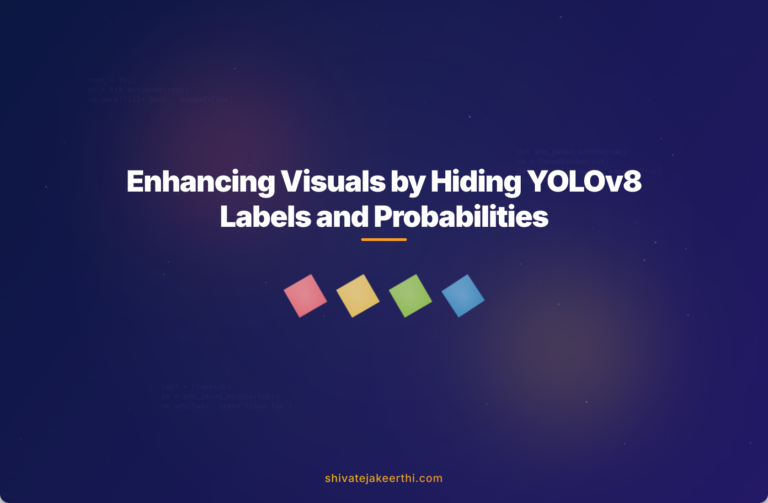YOLOv8 is a popular object-detection framework used widely in computer vision tasks. It stands out for its speed and accuracy, offering real-time detection capabilities useful in many industries. By default, YOLO predictions show bounding boxes alongside labels and the model’s confidence levels. While helpful during model development or debugging, these labels and probability scores may not always be necessary—or even desirable—in your final application images.
Imagine you need to share detection outputs publicly or integrate them into a marketing presentation. The presence of detailed labels and probabilities might clutter your visuals or inadvertently expose sensitive internal data.
In such cases, customizing YOLOv8’s output by hiding labels and probabilities is advantageous both in terms of clarity and privacy. Let’s explore in detail why and how to do this effectively.
Why It Matters to Hide Labels and Probabilities
There are several reasons you might choose to remove labels and probabilities from YOLOv8 prediction images:
- Privacy Concerns: Especially critical for surveillance, safety monitoring, or security applications—revealing the model’s internal classification data or probability scores might compromise sensitive information or cause privacy issues.
- Streamlined Outputs: For visual clean-up, hiding labels can declutter the prediction images, making them cleaner and more professional-looking—ideal for marketing materials or presentations.
- Tailored Use Cases: Sometimes, the exact label and probabilities simply aren’t relevant for your target audience, or you prefer alternative visualizations like bounding boxes alone.
Step-by-Step Guide: How to Hide Labels and Probabilities in YOLOv8 Predictions
Ready to try it? Let’s dive into practical steps, from setup to implementation.
Step 1: Install Necessary Libraries
First, ensure that you have YOLOv8 set up. Install it easily with pip:
pip install ultralytics
The ultralytics repository on GitHub holds comprehensive setup instructions if you face installation issues.
Step 2: Load the YOLOv8 Model
Let’s use YOLOv8’s pre-trained model for demonstration purposes. Here’s how you can start quickly:
from ultralytics import YOLO
# Load a pre-trained YOLOv8 model
model = YOLO("yolov8n.pt") # Use yolov8n as it's faster and lighter
All available models and weights can be found at the official YOLOv8 documentation site.
Step 3: Generate Predictions and Hide Labels/Probabilities
When visualizing or saving detection results using YOLOv8, you have control over what components appear. Here’s how to hide labels and probabilities in images:
# generate predictions on your image
results = model.predict(source="your_image.jpg")
# Save predictions without labels and probabilities
for r in results:
im_array = r.plot(labels=False, conf=False) # hides labels and probabilities
r.save(filename="prediction_no_labels.jpg")
After running the code above, your saved predictions will contain bounding boxes—without any additional label or probability clutter.
Let’s Understand the Code Above
Below is a clear break down of the critical lines:
- model.predict(source=”your_image.jpg”): Loads your image and runs it through YOLOv8, returning detected objects in bounding boxes.
- r.plot(labels=False, conf=False): This line explicitly hides both labels and confidence scores in the plotted predictions. To show them again, simply set these parameters to True.
- r.save(filename=”prediction_no_labels.jpg”): This saves the resulting image in your working directory.
Want other modifications? For instance, changing bounding box colors or thickness? The YOLOv8 Predict documentation provides extensive details on visualization settings.
Best Practices When Adjusting YOLOv8 Outputs
While adjusting YOLO’s output settings seems straightforward, remember these tips:
- Maintain Output Quality: Before hiding labels or probabilities permanently, ensure your model predictions are accurate and tested thoroughly. Removing labels prematurely can impede debugging efforts.
- Test and Verify: Make sure the associated bounding boxes remain correctly placed around relevant objects after customization. Regularly validate and debug your Python code whenever you modify output parameters.
- Performance Trade-offs: Small visualization adjustments won’t typically affect YOLOv8’s speed much, but if you create extensive visualizations or frequently save multiple images in batch mode, check performance frequently to avoid bottlenecks.
Potential Use Cases: When Hiding Labels Makes Sense
Still unsure if hiding labels fits your scenario? Here are some common practical applications:
- Surveillance and Security: In public surveillance feeds, you might want detection bounding boxes visible without revealing detailed classification or confidence score, improving security privacy.
- Research & Academia: In experimental research, visualization experiments might demand clear data representation with bounding boxes minus probabilities to avoid influencing viewer bias.
- Marketing & Advertising: Promotional visuals based on object detection often prefer clean, professional-looking images free from distractive technical annotations.
In short, the flexibility gained from selectively showing YOLO predictions provides clarity, privacy, and a polished look wherever necessary.
By mastering YOLO’s customization options, you’re empowered to create tailored visuals uniquely suited to your needs.
The key takeaway: knowing when and how to adjust these outputs can significantly impact public perception, privacy standards, and visual clarity in your final product.
Why not give it a try in your next YOLOv8 project? Feel free to experiment with different settings to see which visualization suits your use-case best.
Have you encountered scenarios where hidden labels improved your application images? Share your experiences!



0 Comments